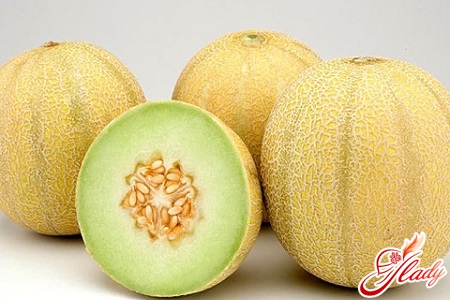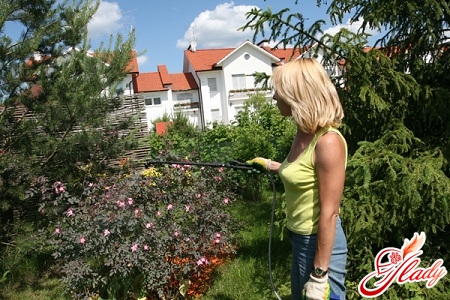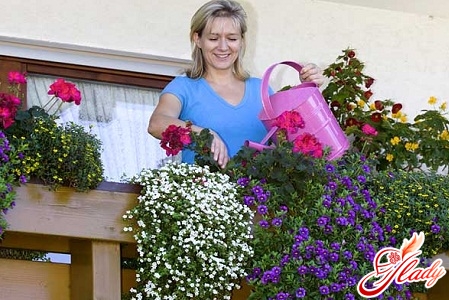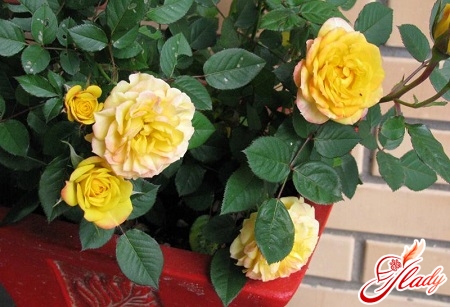 Probably everyone who watches at least oncea wonderful film "The Snow Queen" on the book of the same name, can recall those beautiful roses that blossomed on the window of Gerda and Kaya. What mistress would not want to grow such flowers on her windowsill? Fortunately, with the initial stage now everything is much easier - with the current diversity in the flower market, finding the desired is very easy. But here the pink bush is bought, it is ideal and pleases the eye, but after a while the question arises: how to care for roses, so as not to lose this beauty? With proper handling of these flowers, they will not lose their exquisite decorativeness, and if desired, they can easily be multiplied.
Probably everyone who watches at least oncea wonderful film "The Snow Queen" on the book of the same name, can recall those beautiful roses that blossomed on the window of Gerda and Kaya. What mistress would not want to grow such flowers on her windowsill? Fortunately, with the initial stage now everything is much easier - with the current diversity in the flower market, finding the desired is very easy. But here the pink bush is bought, it is ideal and pleases the eye, but after a while the question arises: how to care for roses, so as not to lose this beauty? With proper handling of these flowers, they will not lose their exquisite decorativeness, and if desired, they can easily be multiplied. 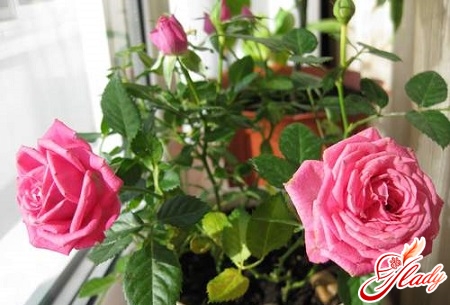
Tips for a Beginner Florist
First, a person's desire, just thatwho bought a beautiful rose bush in an ordinary-looking plastic pot or container, transplanted the flowers into something more decent - quite understandable, but erroneous. In no case can they be transplanted immediately. Put a boring pot on a window facing south or southeast and leave it for two to three weeks. If the new inhabitant of the home garden does not show signs of illness and wilting, it can be transplanted. When transplanting a rose, remember that you should not take too large a pot for these purposes. It should not be much larger than the previous one - plus five centimeters in height and the same amount of increased diameter will be more than enough. Do not forget about drainage, without it all your subsequent efforts will go wrong. Drainage is laid on the bottom by a layer not less than one centimeter thick; If there is no drainage hole in the pot, the layer should be increased to three centimeters. On top of the drainage, specially prepared land is covered. It is best to use special mixtures for roses - unfortunately, in urban conditions it is difficult to prepare a suitable soil yourself. Before transplanting flowers in a new pot, the latter must be processed. If it is ceramic and nothing has been grown in it, soak it in warm water for a couple of hours. If it was already used for growing flowers, it would be enough to treat it without soap with a stiff brush. Remember, roses are very, very sensitive to any damage to the roots, so transfer them from the pot to the pot by the method of transshipment, without scattering the earth litter, minimizing the possibility of accidentally damaging the roots. Usually, from the top of the coma, a small amount of soil is removed, gently loosening it. It is believed that it is best to transplant on a growing moon. It should be remembered that roses like the south and south-east, fresh air, regular watering, fertilizing once a week during flowering, increasing the pot as it grows, regular spraying, but they do not like warm wintering, pests, cold watering, overheating. At first glance it seems that there are too many rules, but in fact, caring for roses is not so complicated. After a month after the transplant, the flower should be fed. It is necessary to understand that the plants that have just been transplanted or diseased should not be subjected to this procedure, besides it is not worthwhile to spend it in rainy, cold weather. As a rule, such care consists in watering the plant with a special liquid fertilizer or Mullein solution in the evenings after watering. Rules for seasonal care for a rose How should care for a rose depending on the season? Summer With the onset of heat, it makes sense to put a flower on a balcony, roses like fresh air and begin to more actively blossom and grow. When the first buds appear, it is best to cut them, letting the plant grow stronger, then in the future it will blossom more luxuriously and for a long time. Flowers that begin to fade, should be removed immediately, with a sharp knife or a pruner, until the kidney next to the flower. In general, the rose must be regularly cut to remove withered branches, rotten leaves and other debris, which can be an indicator of the onset of the disease. Also do not forget to spray the leaves of the plant and make sure that it does not overheat. In the summer, the rose needs a very careful care, because it does not like strong heat and lack of watering. While there is active growth of the plant, fertilizing is needed. If the growth is so fast that the rose bush is cramped in the pot, transfer it to a larger one, but only in the phase of the growing moon. Autumn As soon as the night temperature drops to fifteen degrees, bring the rose into the room and put it on the south window, it's best to put it between the frames or not to insulate the window on which it stands. If there is no such possibility, carefully make sure that next to the flower there were no heating elements. It easily tolerates the cold and even slight frosts, but the overheating for the rose bush is fatal. In order to prepare a rose for the winter, it is taught to save water more economically, leaving the dry ground for a couple of days, and stop feeding. Note: if you suddenly used nitrogen fertilizers, by the end of summer they should be replaced by any other. Nitrogen is not needed for a good wintering of a rose. At the same time, a rose is usually cut so that there are five kidneys left on each branch. Such care will allow the plant to next year to embark on flowering with new forces. Cropped branches are often used for reproduction. To do this, cut from them cuttings about fifteen centimeters long (each should have three or four living kidneys and several leaves) and put in water at room temperature for rooting. Note that the water in which the cuttings are standing, in no case can not be changed, even if it turns green, you need to pour new as needed. Additionally, you do not need to take care of the cuttings. Roots appear, as a rule, in a couple of weeks, but to transplant sprouts to the ground is after the root system is at least slightly branched. They should be planted in small pots, preferably in the phase of the growing moon. Winter At this time of year, the rose does not grow, but follows the example of older brethren and discards the leaves. It should be seldom watered, leaving the land dry for two to three days, and sprinkle. If your apartment is very dry, put a pot of plant on a dish with wet gravel or pebbles and regularly moisten stones. Rose needs you to produce such extra care, as it does not tolerate too dry air. In February, the flower makes sense to rearrange it in a warmer room, possibly by transferring it to a new land. Spring Rosa begins to revive, growing new branches and leaves, so it should be watered more often and abundantly, leaving the land dry for no more than a day. At this time, it's time to start fertilizing again. It can be a full mineral fertilizer, a solution of mullein or bird droppings. Top dressing should be done immediately after watering. To make it bloom more luxuriantly, after the first buds are formed, the rose must be fed once a week. Make sure that at this stage the flower is short of light and moisture. Perhaps it makes sense to rearrange the pot to the lightest window. After the weather has become steadily warm, it's time to put a rose on the balcony. Do not expose the flower to bright light immediately, you must first accustom it to the light. If your balcony does not have a corner with a shadow, use for two weeks a sheet of paper with stabbed holes in order to cover the plant from the sun. 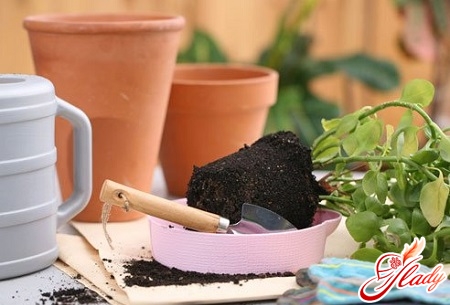
Diseases of the rose
The most common disease in the case ofRose is powdery mildew - a disease that has a fungal character. The reason for it, as a rule, are poor sanitary conditions and pests, such as aphids, scabbards, chervets. After these insects on the leaves of the rose remains a sweet secret, which is an ideal basis for the development of fungus. Powdery mildew looks like a whitish scurf on leaves and flowers, with the development of the disease the plaque changes color to a darker color and creeps onto the stems. Downy powdery mildew differs in that the plaque spreads under the leaves and appears on their surface with darker spots. The first thing to do is to cut off the affected leaves and flowers, disinfecting the pruner or knife after each action, then you can try to use one of the most common ways to combat this disease. If powdery mildew has strongly captured the plant - alas, it is better to get rid of it until it infects adjacent flowers. To combat this disease, you can use a group of antifungal drugs, which are called fungicides. In this case, you just need to follow the instructions that came with the tool. If for some reason you do not want to use ready-made chemicals, try a mixture of laundry soap and copper sulfate. To do this, take one liter of water, twenty-five grams of laundry soap and two or three grams of copper sulfate. Each ingredient is diluted in water separately, then both solutions must be mixed. Spray the sick plant at a frequency of three to seven days before recovery. This method can also be applied in case the rose is ill with gray mold. Gray rot is also a fungal disease. Occurs with high humidity. It affects flowers and green shoots, enveloping them in a gray fluff. Fight it with the help of the above mentioned means, plus it can be used for preventive treatment of healthy plants. Unfortunately, roses are very susceptible to this disease, so keep an eye on the condition of these plants very carefully. Pests Spider mite. Alas, this insect is very fond of roses. Omitting the plant with a thin web (branches, flowers and even buds), it can destroy it in a few days. It is possible to fight the mite with hot (about fifty degrees) soapy water, washing the leaves of the rose with it. The proportions of the solution are the following: 1 liter of water, 20 grams of liquid green soap. So you need to take care of the plant for several weeks. Instead, you can use the infusion of garlic or onions, which need to regularly spray the plant, until the pest disappears. Instead of household funds you can buy a professional. Decorative rose pleases the eye, after it with minimal experience it is easy to take care of, and its fragrance and fragile beauty create a special atmosphere. Is this not a reason to think about taking this flower?




